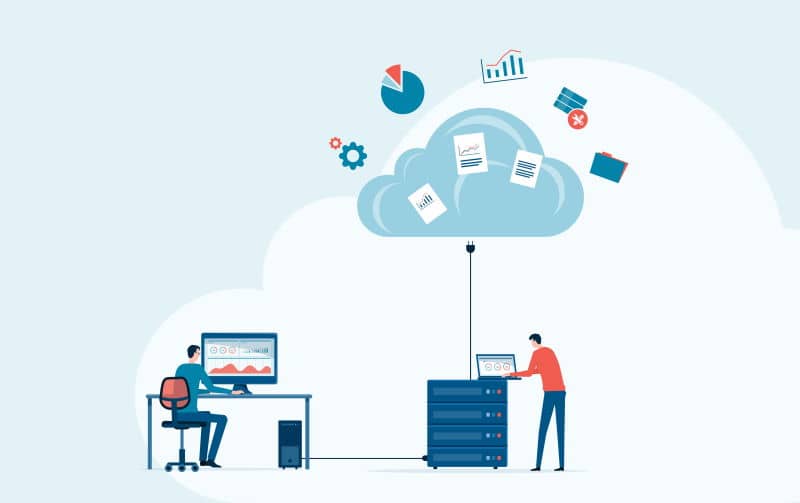Whether small or large, local or international, each company needs a well-maintained IT infrastructure to support its day-to-day business operations. However, having efficient software, hardware, and other system and infrastructure components is easier said than done. Achieving its maximum efficiency can be a daunting task if you do not know where to start.
Your software and hardware infrastructure can be outdated, inefficient, and a drag on your company's productivity if you don't know how to optimize it. For a good place to start, read through this article and follow the tips outlined here to optimize your IT infrastructure and enhance the quality of your business system.
1. Outsourcing
IT infrastructure management includes various tasks, from device installation and maintenance to systems monitoring and security. Suppose your company does not have the human resources or technical expertise to maintain a competent IT department. In that case, it may be a better idea to partner with a Dallas managed IT services provider like Accudata or other managed services providers to outsource your IT infrastructure management.
Outsourcing ensures that your company's IT needs are met with minimum to no margin for error, as professional service providers have the necessary technical skills and experience to maintain a smooth-running IT infrastructure. For businesses based in Sydney or those with specific regional needs, partnering with a service provider like Truis offers tailored IT-managed services, providing local expertise and a reliable support structure. Whether your business requires comprehensive IT infrastructure support or cloud-based solutions, outsourcing these critical functions can give you peace of mind and let your team focus on core operations.
2. Audits
Conducting an audit enables businesses to understand the current infrastructure's shortcomings and to determine what they can improve for better results. Audits should also make it possible to uncover any security risks or inefficiencies that may affect your company's productivity.
An IT audit may include the following:
-
Checking if the current infrastructure is adequate and scalable
-
Checking if the data storage and backup systems are efficient
-
Reviewing the company's disaster recovery plan
-
Checking if the infrastructure’s security is in line with business needs.
3. Regular Maintenance
Purchasing new IT equipment is a good idea, but only when your company's current equipment has reached the end of its life cycle. The expenses incurred in purchasing new devices and software may be higher than the cost of extending the life span of older equipment. Regularly scheduled maintenance ensures that your devices and software run efficiently, while also extending their life span.
An IT infrastructure maintenance plan should include the following:
-
Desktop maintenance
-
Server maintenance
-
Security maintenance
-
Backup maintenance
Having an effective maintenance plan in place and keeping all your components up-to-date will make finding and fixing bugs easier. Moreover, this type of proactive maintenance can help prevent bigger issues in the future.
4. Strong Security
Data loss and hacking are real risks that can severely damage a company's reputation. Thus, it's necessary to take security seriously. Setting up firewalls and creating strong passwords are just some ways to help prevent data loss. Having robust antivirus software and software firewalls can also go a long way toward protecting your data.
The business's IT department should also conduct routine testing to determine if vulnerabilities exist in their systems. Regular testing allows them to patch the security holes before they become a problem.
Businesses often consider partnering with a professional IT Support Austin team (or similar professionals elsewhere) that can provide additional expertise, ensuring that security protocols are up-to-date and tailored to protect against evolving cyber threats.
5. Automation
Automation is not just about saving time and effort; it's also a way to ensure that your IT infrastructure operates smoothly and efficiently. Automation reduces human error, thus eliminating the possibility of a mistake that could cause a malfunction in your systems.
For example, if your business runs on a third-party email server, using automated software backups will save you the time and effort that may be involved in manual email data restoration procedures. With automated backups, your business won't have to worry about data loss, enabling you to focus on your day-to-day operations.
6. Cloud Solutions
Cloud solutions are a good option for companies that need flexibility and maximum scalability. For example, if your company is growing rapidly, you may want to scale up without significantly increasing your IT infrastructure budget. So instead of investing in computing devices and software, you could consider moving some of your systems to the cloud.
Cloud services offer various advantages that will allow your company to scale up. The cloud can enable companies to create virtual servers to increase their productivity without the associated hardware costs.
Final Words
Optimizing your company's IT infrastructure can be a lengthy process, but it's a necessary procedure that ensures continuity, especially as the business continues to grow. Though it may seem extensive, all the tips above are guaranteed to help with optimization, as they each bring their own set of advantages.
Outsourcing your IT infrastructure needs and having a proper maintenance plan could give you peace of mind, knowing that your systems are running smoothly and that your company's data is secure. Automating and utilizing cloud solutions can provide the flexibility and scalability that manual approaches lack. And with regular IT audits and proper maintenance, you could improve your company's efficiency and prevent future issues from occurring.
With that said, while this is by no means an exhaustive list, it’s a good place to start. Consider implementing these tips and expect to see an improvement in your business’s IT infrastructure.








